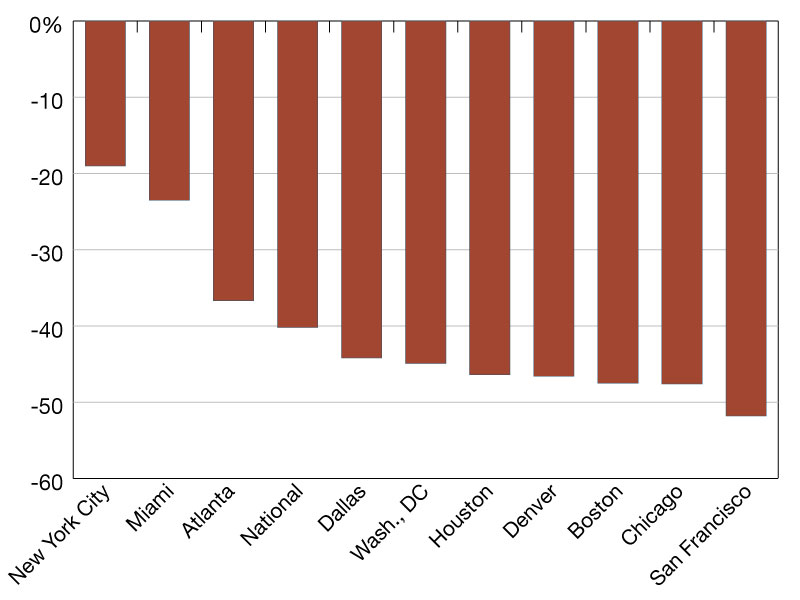Placer.ai Office Index—January 2025 Recap
Find out how visits are trending in major cities.
Nationwide, January 2025 office visits were 40.2 percent lower when compared to pre-pandemic January 2019. A confluence of factors, including last month’s polar vortex, as well as the mid-week New Year’s Day, likely resulted in fewer office visits than usual.
New York continued to lead the return-to-office pack, with office visits in the Big Apple just 19.0 percent lower than in January 2019. Analyzing the year-over-year data indicates that the polar vortex likely had a greater impact on employees in typically warmer climates while employees in cities that tend to have colder winters seemed less affected.
Temporary setback for RTO
Several factors seem to have converged in January 2025 to temporarily hamper the return-to-office recovery. First, last month brought a polar vortex to much of the United States, compelling Americans to stay indoors and avoid unnecessary trips outside—including to the office. January 1st also fell on a Wednesday this year, and many people likely took advantage of the calendar luck to extend their vacation through the weekend—leading to fewer January office visits compared to years when New Year’s Day falls earlier in the week.
As a result, the January 2025 bump appeared relatively muted: visits in January 2025 were only 17.7 percent higher than in December 2024, compared to a 31.3 percent month-over-month increase from December 2023 to January 2024. And visits were 40.2 percent lower than they were in pre-pandemic January 2019—a slightly worse showing than the 39.2 percent pre-pandemic visit gap of December 2024.
New York continues to lead the RTO pack
The meteorological and calendar challenges seem to have impacted office visits on a metro area as well, with few cities analyzed making significant RTO strides in January 2025. The sole exception was New York, where January 2025 visits were only 19.0 percent lower than they were in January 2019—a slightly smaller visit gap than the previous month.
Many of the cities where residents are used to and equipped for the colder weather—Chicago, Boston, and New York—seemed to have experienced a relatively minimal impact from the arctic blast. The one exception was Denver, which was exceptionally frigid—with subzero temperatures—so that even those used to cold may have opted to work from home.
But in metro areas where weather tends to be relatively warm—including Atlanta, Houston, Washington, D.C., and Dallas—the impact of the polar vortex was visibly stronger. In these cities, the year-over-year visit gap ranged from 7.5 percent (Atlanta) to 12.0 percent (Dallas)—as employees without proper winter jackets or snow tires likely chose to stay cozy and avoid the chill.
January 2025’s RTO stats may not have been particularly impressive, but the relatively weak office data is likely more a reflection of last month’s unique challenges rather than a slowdown in the RTO momentum. With the weather now back to normal and no mid-week holidays in the near future, the coming months will be critical in evaluating if the RTO is in fact slowing down or whether January just marked a temporary setback within a still unfolding story.
For more data-driven insights, visit placer.ai.
This blog includes data from Placer.ai Data Version 2.1, which introduces a new dynamic model that stabilizes daily fluctuations in the panel, improving accuracy and alignment with external ground truth sources.
—Posted on February 26, 2025








You must be logged in to post a comment.